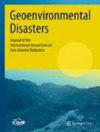Study on the correlation between real-time GNSS landslide acceleration monitoring and earthquake response: a case of May 2, 2023, MW = 5.2 Baoshan earthquake, Yunnan
IF 4
Q2 ENVIRONMENTAL SCIENCES
引用次数: 0
Abstract
Earthquakes and landslides pose significant threats to human safety and property, necessitating early warning systems. However, the high construction costs of earthquake early warning systems present a challenge. Landslide warnings are more prevalent, so linking them to earthquake warnings could address cost concerns. Hence, it is crucial to validate the feasibility of utilizing GNSS landslide monitoring as assistance for earthquake early warning systems. This paper analyzes acceleration anomaly data from 31 GNSS landslide monitoring points near the epicenter of the May 2, 2023, MW = 5.2 Baoshan earthquake in Yunnan. The response time was determined as the time difference between an earthquake's occurrence and GNSS's acceleration anomalies. This calculation helps measure the time delay and sensitivity between these two events. Data were obtained from the geological disaster monitoring and early warning management system. GNSS landslide monitoring showed high sensitivity to nearby earthquakes. The fastest response time among the 31 data points was 8 seconds, while the slowest was 56 seconds, all falling within the one-minute mark. A linear correlation was found between acceleration anomaly response time and distance from the epicenter, indicating the feasibility of GNSS landslide monitoring-assisted earthquake monitoring. A proposal is made for a GNSS landslide monitoring cluster to establish a multi-dimensional landslideearthquake disaster warning system. This approach offers new methods for combining earthquake and landslide early warning systems, leveraging existing infrastructure for cost-effectiveness and enhancing disaster preparedness.全球导航卫星系统(GNSS)滑坡加速度实时监测与地震响应相关性研究:以 2023 年 5 月 2 日云南保山 5.2 级地震为例
地震和山体滑坡对人类安全和财产构成重大威胁,因此有必要建立预警系统。然而,地震预警系统的建设成本较高,这是一个挑战。山体滑坡预警更为普遍,因此将其与地震预警联系起来可以解决成本问题。因此,验证利用全球导航卫星系统滑坡监测作为地震预警系统辅助手段的可行性至关重要。本文分析了 2023 年 5 月 2 日云南保山 MW=5.2 级地震震中附近 31 个 GNSS 滑坡监测点的加速度异常数据。响应时间被确定为地震发生与 GNSS 加速度异常之间的时间差。这种计算方法有助于测量这两个事件之间的时间延迟和灵敏度。数据来自地质灾害监测和预警管理系统。全球导航卫星系统滑坡监测显示出对附近地震的高度敏感性。在 31 个数据点中,反应时间最快的为 8 秒,最慢的为 56 秒,均在一分钟之内。加速度异常响应时间与震中距离之间呈线性相关,表明全球导航卫星系统滑坡监测辅助地震监测是可行的。建议利用全球导航卫星系统滑坡监测集群建立多维滑坡地震灾害预警系统。这种方法为地震和滑坡预警系统的结合提供了新的方法,可利用现有基础设施提高成本效益并加强备灾能力。
本文章由计算机程序翻译,如有差异,请以英文原文为准。
求助全文
约1分钟内获得全文
求助全文
来源期刊

Geoenvironmental Disasters
Social Sciences-Geography, Planning and Development
CiteScore
8.90
自引率
6.20%
发文量
22
期刊介绍:
Geoenvironmental Disasters is an international journal with a focus on multi-disciplinary applied and fundamental research and the effects and impacts on infrastructure, society and the environment of geoenvironmental disasters triggered by various types of geo-hazards (e.g. earthquakes, volcanic activity, landslides, tsunamis, intensive erosion and hydro-meteorological events).
The integrated study of Geoenvironmental Disasters is an emerging and composite field of research interfacing with areas traditionally within civil engineering, earth sciences, atmospheric sciences and the life sciences. It centers on the interactions within and between the Earth''s ground, air and water environments, all of which are affected by climate, geological, morphological and anthropological processes; and biological and ecological cycles. Disasters are dynamic forces which can change the Earth pervasively, rapidly, or abruptly, and which can generate lasting effects on the natural and built environments.
The journal publishes research papers, case studies and quick reports of recent geoenvironmental disasters, review papers and technical reports of various geoenvironmental disaster-related case studies. The focus on case studies and quick reports of recent geoenvironmental disasters helps to advance the practical understanding of geoenvironmental disasters and to inform future research priorities; they are a major component of the journal. The journal aims for the rapid publication of research papers at a high scientific level. The journal welcomes proposals for special issues reflecting the trends in geoenvironmental disaster reduction and monothematic issues. Researchers and practitioners are encouraged to submit original, unpublished contributions.
 求助内容:
求助内容: 应助结果提醒方式:
应助结果提醒方式:


